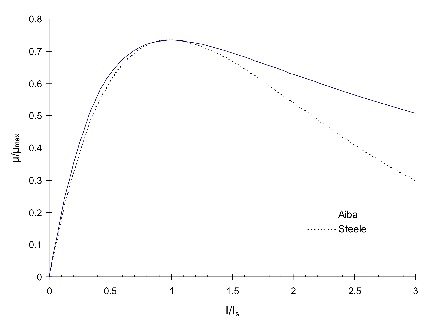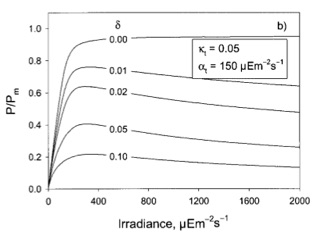2. Microalgal Growth Kinetics.


2.3. Photolimitation and photoinhibition.
-
•Photoinhibition.
When light becomes too intense, usually well over the saturation point, the photosynthetic process gets impaired and the photosynthesis rate decreases. This is known as photoinhibition.
In point of fact, photoinhibition is a very specific process in which certain components of the photosynthetic aparatus become reversibly deactivated. It is actually a regulating mechanism that starts a protective strategy when the photon flux becomes too intense for the metabolism of the microalgae to cope with the electron transfer rate it would require.
Some models have been specifically developed to deal with photoinhibition.
Questions:
-
• Find for all the models at what I happens that µ=µmax/2?
-
• What happent to the Camacho-Rubio model when k=0?
-
• What are these models dealing with as written, gross or net growth rate?
-
• Write some of the equations for the net rate vs I relationship.
LITERATURE
Aiba S. (1982) Growth kinetics of photosynthetic microorganisms. Adv. Biochem. Eng. 23: 85-156
Steele, J.H., (1977) Microbial kinetics and dynamics in Chemical Reactor Theory. Lapidus, L., Amundson, N.R., Prentice-Hall Englewood Cliffs, Capter 7, 405-483
-
•The Aiba model.
Andrews (1968) developed an inhibition model for substrate-inhibited enzymatic kinetics:
Aiba (1982) proposed an analogous equation for light-limited growth:
-
•The Steele model
Steele (1977) proposed the following model for photosynthetic microorganisms:
The Aiba and the Steele model are compared in the next picture:
-
•The Camacho-Rubio model.
The model proposed by Camacho-Rubio (2003) also takes into account photoinhibition. The case for photoinhibition under continuous light gives the following equation:
The behaviour of this equation is shown in the next picture for some selected conditions.






-
•A word about photoinhibition from an engineer’s standpoint.
Other model are available if you need to account for photoinhibition. Some are given here:
But from the point of wiev of mass production, photoinhibition is always a no-win situation. Potoihnibition must be detected and avoided. I cannot think of a situation in which you may want to design a photobioreactor to operate under photoinhibiting conditions.






